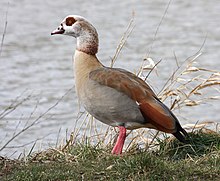Alopochen
Appearance
| Alopochen | |
|---|---|

| |
| Egyptian goose | |
| Scientific classification | |
| Domain: | Eukaryota |
| Kingdom: | Animalia |
| Phylum: | Chordata |
| Class: | Aves |
| Order: | Anseriformes |
| Family: | Anatidae |
| Subfamily: | Tadorninae |
| Genus: | Alopochen Stejneger, 1885 |
| Synonyms | |
Alopochen is a genus of the bird family Anatidae, part of the subfamily Tadorninae along with the shelducks. It contains one extant species, the Egyptian goose (Alopochen aegyptiaca), and two or three species which became extinct in the last 1000 years or so. The Egyptian goose is native to mainland Africa, and the extinct species are from Madagascar and the Mascarene Islands.
mtDNA cytochrome b sequence data suggest that the relationships of Alopochen to Tadorna need further investigation.[3]
Species
- Egyptian goose, Alopochen aegyptiaca
The extinct species of the genus are:
- Malagasy shelduck or Madagascar shelduck, Alopochen sirabensis (Andrews 1897) (may be subspecies of A. mauritiana) – Madagascar, prehistoric: see Late Quaternary prehistoric birds
- Mauritius sheldgoose, Alopochen mauritiana (Newton & Gadow 1893)– Mauritius, late 1690s
- Réunion sheldgoose or Kervazo's Egyptian goose, Alopochen kervazoi (Cowles 1994) Mourer-Chauviré et al. 1999– Réunion, circa 1690s
- Alopochen tarabukini (Kuročkin & Ganea) Mlíkovský 2002
The generic name looks like Greek ἀλώπηξ + χήν = "fox-goose", referring to the colour of its back, but with a Greek language error; the linguistically correct form would have been *Alopecchen or *Alopecochen.
References
Wikimedia Commons has media related to Alopochen.
- ^ Jobling, James A. (2010). The Helm Dictionary of Scientific Bird Names. London: Christopher Helm. p. 100. ISBN 978-1-4081-2501-4.
- ^ "Part 7- Vertebrates". Collection of genus-group names in a systematic arrangement. Archived from the original on 5 October 2016. Retrieved 30 June 2016.
- ^ Sraml, M.; Christidis, L.; Easteal, S.; Horn, P.; Collet, C. (1996). "Molecular Relationships Within Australasian Waterfowl (Anseriformes)". Australian Journal of Zoology. 44 (1): 47–58. doi:10.1071/ZO9960047.


